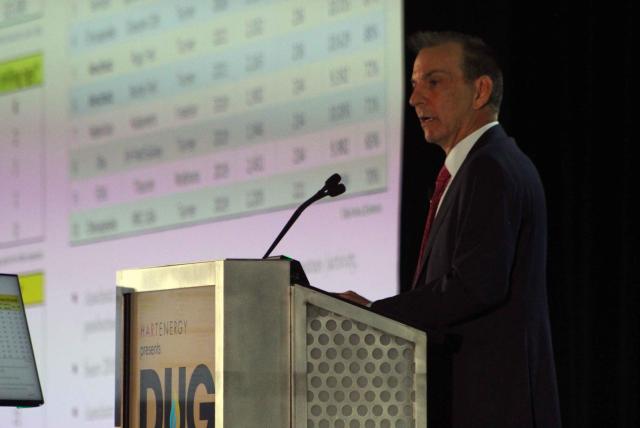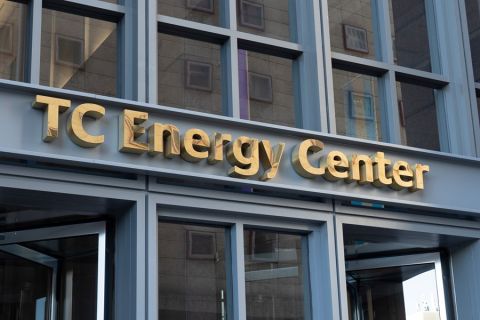
Anschutz Exploration, a private, independent oil and gas company, rounds out the top five Powder River Basin players for activity, acreage and production with four public companies: Continental, EOG, Occidental and Devon. (Source: Joseph Markman / Hart Energy)
DENVER—If investors are worried about the potential for production and profit in the Powder River Basin, all they need to do is talk to Anschutz Exploration Corp.’s president and CEO, Joe DeDominic.
Indeed, having worked in the Powder River for some 50 years, the private, independent oil and gas company has mastered—or at least, largely prevailed upon—many of the greatest challenges involved with developing the play: cost, drilling times, inconsistent well results and takeaway capacity.
Based in Denver, Anschutz currently owns leases on 475,000 net acres in the Powder River Basin with interests in 486 gross wells, four active drilling rigs and 26,000 net boe/d (75% oil). The company rounds out the top five Powder River Basin players for activity, acreage and production with four public companies: Continental Resources Inc., EOG Resources Inc., Occidental Petroleum Corp. and Devon Energy Corp.
DeDominc said Anschutz currently has three of the basin’s top 10 wells.
“However, early 2022 well results indicate Anschutz is most likely to see three to four additional wells in the top 10 by year-end,” he told the crowd gathered on June 29 for Hart Energy’s DUG Bakken and Rockies Conference and Exhibition.
“Early 2022 well results indicate Anschutz is most likely to see three to four additional [Powder River] wells in the top 10 by year-end.”—Joe DeDominic, president and CEO, Anschutz Exploration Corp.
Anschutz drillings times are declining as a result of the transition from appraisal to full-scale development and the company’s increased focus on “repeatable results,” he said. A composite of the best well in Anschutz’s arsenal improved from 11.8 days in 2020 to 7.8 days in early 2022.
As for cost, the company’s gas reduced its cash operating expense by 55% since 2019, driving down total well cost per lateral foot by some 40% during the same period. Debundling, process optimization and supply chain alignment changes appear sustainable and help keep inflation capped in the Powder River Basin, DeDominic said.
Moreover, he added the Powder River Basin has continued to maintain reliable netbacks on oil and gas because infrastructure capacity is largely balanced—contrary to other busy shale plays in the U.S.
Prior development periods put into place necessary pipelines, electrical services and water lines that assist the Powder River Basin producers on the midstream side. And strong gas realizations and liquids yields make the midstream competitive in the area, another benefit to bottom-line expenses, he said.
Contrary to regulatory action in other parts of the Lower 48, federal regulations are largely working in favor of increased development. According to DeDominic, the current average for a federal lease approval is four months.
“A planning program with an 18- to 24-month time frame to secure drillable federal permits will allow operators to facilitate increased development pace is warranted,” he said.
Anschutz is a private firm and has no debt. Its core position and its repeatable, positive cost structure allow the Powder River asset to generate significant cash flow with limited capital deployment. And, the asset is cash flow positive with sustained development with WTI oil priced in the low $50s/bbl.
The company’s inventory may provide upside opportunity for more than 20 years as a rig pace of 2.5, DeDominic said. That pace beginning in 2023 may generate high single-digit production growth using 70% of cash flow.
The firm intends to close out 2022 with production between 26,000-28,000 boe/d (73% oil, 86% liquids); for next year, the plan is production between 38,000-42,000 boe/d (62% oil, 83% liquids)— a growth pace on the high end of the year-over-year forecast of more than 40%.
Recommended Reading
TC Energy Appoints Sean O’Donnell as Executive VP, CFO
2024-04-03 - Prior to joining TC Energy, O’Donnell worked with Quantum Capital Group for 13 years as an operating partner and served on the firm’s investment committee.
CorEnergy Infrastructure to Reorganize in Pre-packaged Bankruptcy
2024-02-26 - CorEnergy, coming off a January sale of its MoGas and Omega pipeline and gathering systems, filed for bankruptcy protect after reaching an agreement with most of its debtors.
Genesis Energy Declares Quarterly Dividend
2024-04-11 - Genesis Energy declared a quarterly distribution for the quarter ended March 31 for both common and preferred units.
Equitrans Midstream Announces Quarterly Dividends
2024-04-23 - Equitrans' dividends will be paid on May 15 to all applicable ETRN shareholders of record at the close of business on May 7.
Baker Hughes Awarded Saudi Pipeline Technology Contract
2024-04-23 - Baker Hughes will supply centrifugal compressors for Saudi Arabia’s new pipeline system, which aims to increase gas distribution across the kingdom and reduce carbon emissions





